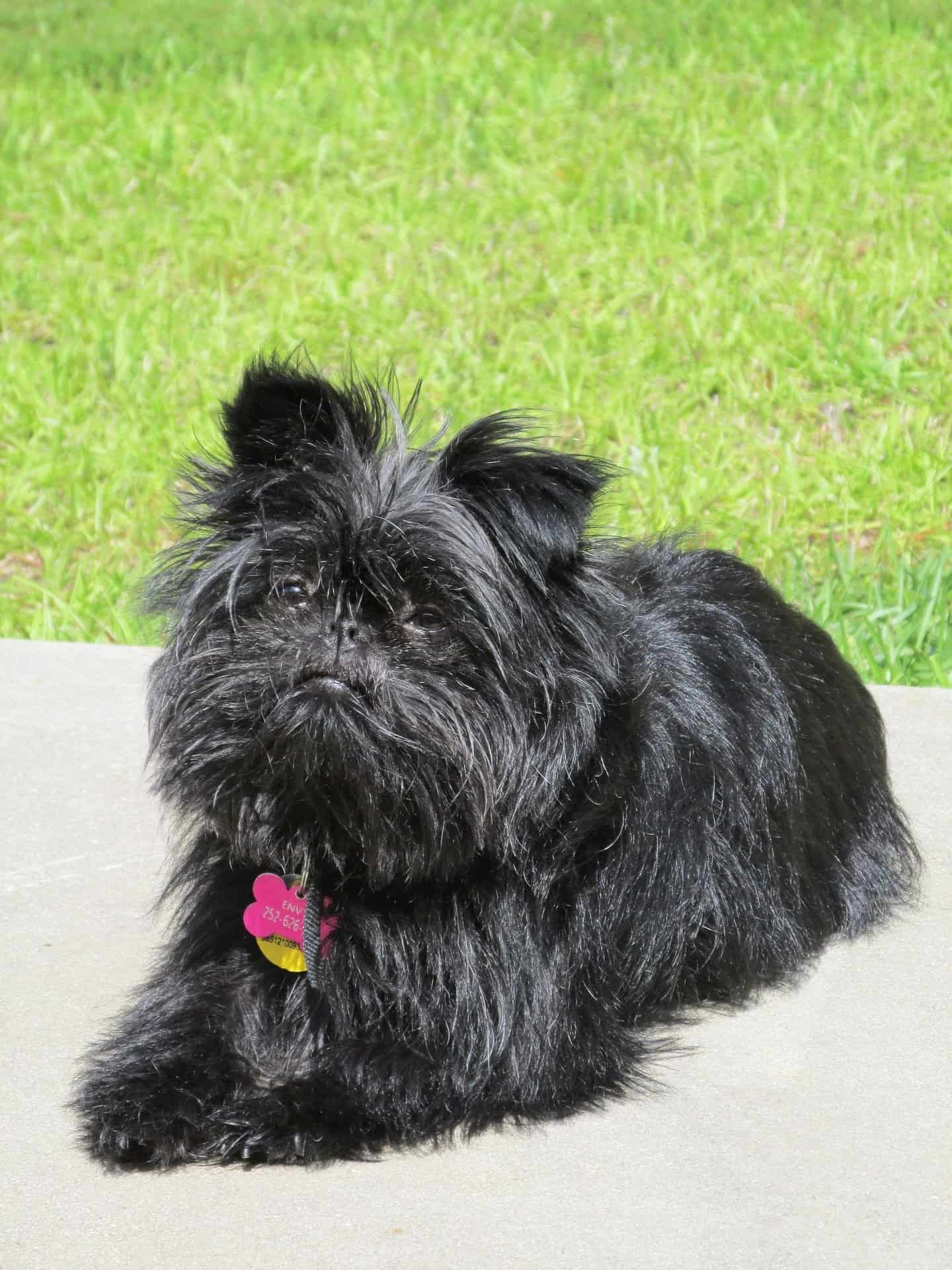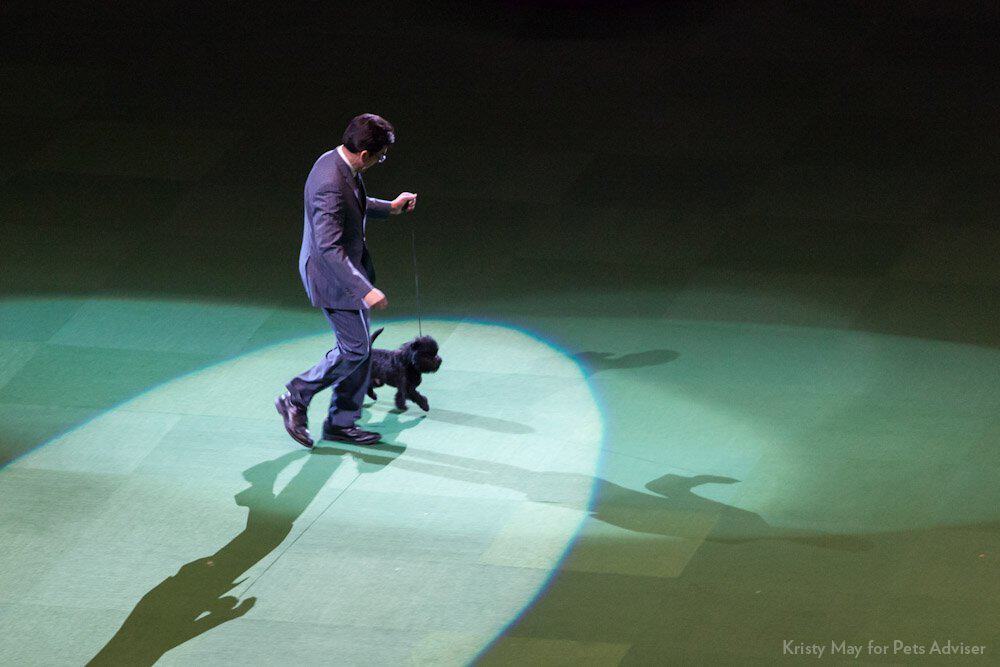Affenpinscher is known for its monkey-like face and short, bristly hair.
Other Names: Monkey Terrier, Affie
Country Of Origin: Germany
Dog Group: Toy
Size: Small
Recommended For: Couples, singles, families with older children
Maintenance Level: Low
Lifespan: 12 to 14 years
Temperament: Playful, active, protective
FAQ:
Good For the First-Time Owner? No
Good With Children? No
Good With Other Animals? Yes
Good With Strangers? Yes
Good For Apartments? Yes
Exercise Requirements? Daily walking
Can Live In Hot Weather? No
Can Live In Cold Weather? Yes
Can Tolerate Being Left Alone? Yes
Grooming? Weekly brushing
Trainability? Moderate/hard
Breed Overview:
Affenpinschers are one of the oldest toy breeds and originated in Germany as mouse catchers in kitchens and barns.
Affies are known to be very bold and have great personalities, which makes them very popular as companion dogs.
Their intelligence and empathy have made them quite popular as therapy dogs.
The breed is tiny but is known to get quite boisterous around larger dogs.
Size: Small
Color: Black, gray, silver, red, black and tan
Coat Length: long, shaggy
Height/Weight Range: H: 9.5-11.5” W: 7-9lbs
Personality And Temperament:
Affenpinschers are very intelligent dogs, and as a result, are very strong-minded.
They are also fiercely independent, but at the same time are very friendly with humans. They need constant attention from their owners, both to keep them happy and to stop them from getting bored.
Although they do enjoy the attention, they can be on their own for more extended periods than some other breeds, which makes them a suitable breed for single people or working couples.
The breed is curious and alert, and they enjoy exploring outdoors.
However, for a small dog breed, they certainly don’t know their size, and regularly try throwing their weight around with larger dogs.
Affenpinchers are also quite excitable, but if this becomes an issue, you should be able to manage it with frequent exercise and training easily.
Affenpinschers can be temperamental around other dogs, and if you want your Affie to be good with other dogs, then you need to make sure you socialize it from an early age.
They can be very boisterous, and so if you don’t get them used to other dogs, there’s every chance they will bark and go for other dogs when out walking.
An easy way to get around these potential complications is to take your dog to puppy obedience classes, as this will allow you to train them, and get them used to other dogs.
When it comes to children, Affenpinschers don’t enjoy potentially dynamic movements and behavior, and they can become very protective of their owners if they believe they are under threat.
For this reason, they’re not suitable to have around small children.
Also, like many other toy dog breeds, Affenpinschers are much more likely to get injured by a child’s well-meaning actions, many of which wouldn’t hurt larger dogs.
You should only really consider getting an Affenpinscher if your children are older, and know how to behave around dogs.
Affenpinschers aren’t a particularly right choice for first-time owners,
mainly because they’re independent, and so can be quite hard to train.
When you’re looking for a first dog, you need one that’s easy to train and guaranteed to behave, which this breed isn’t.
While there’s not a high chance that they’ll become destructive when bored, an experienced owner is much more likely to know how to manage this behavior.
The breed is suitable for both apartments and houses with outside land.
Affenpinschers are a small breed and so can get away with living in an apartment, but also really enjoy running around outside.
If you plan on keeping one in an apartment, you’ll have to spend more time house training it, but once you’ve done this, you should find very little problem keeping them indoors.
Although Affies are small dogs, they like to be very active.
At least one walk a day is recommended, although this can be as long as you want it to.
The breed is active enough to take on a very long walk, but would also be perfectly content with a short one around the block.
This is another reason why they make a good pet for apartment living.
Affenpinschers aren’t well suited for hot weather, both because of their long coat and the shape of their muzzle.
They’re much more likely to overheat on hot days, but you can avoid this if you’re careful when you exercise them.
If you live in a tropical climate, make sure you’ve got air conditioning and that you’re very careful about how active the dog is.
On the other hand, Affenpinschers thrive in colder weather, having originated in Germany. They’re delighted in cold weather and love the snow.
The breed can be quite hard to train, which is mostly due to their independent nature.
They can be difficult to house train, but if you’re committed enough to stick with it, then you’ll have a very well-trained dog by the end of it.
You can train this dog by using the Dog commands in German.

Grooming:
Affenpinschers don’t shed very much, which is a huge blessing.
They will shed when you groom them, but leave much less hair lying around than some other breeds.
Their coat is thick and course and feels quite rough when it’s long, but much smoother when it’s short.
As a general rule, you should brush your Affie once a week.
This only needs to be done with a brush, and you should aim to get all of the knots out of their fur.
Affies can be groomed, and some owners like to keep their coat short all year round, and this is recommended in the summer if you live somewhere hot.
Affies don’t necessarily need regular baths, but it can be beneficial if their coat is long.
If you take them on walks, their coat is more likely to become dirty and tangled with bits, so bathing is an excellent way to keep it in order.
However, you shouldn’t bathe them too regularly. Otherwise, their coat can become dry and brittle.
If you’ve trimmed their coat, there’s very little need to bathe them unless they get dirty.
When it comes to nail clipping, this should be done as often as needed.
Dogs that are regularly walked won’t require their nails to be clipped as often, but apartment dogs will need to be cut regularly.
It’s also worth brushing their teeth regularly because the breed is quite susceptible to dental problems.
It should be done at least twice a week, but more regularly if you think your dog is at risk of dental disease.
Common Diseases And Conditions:
Affenpinschers are generally quite a healthy breed, but purebred dogs are more likely to be prone to genetic diseases.
Many of these come on as the dog gets older, and when it comes to diagnosis, you should keep an eye out for symptoms but get your vet to confirm if you have any suspicions.
The most common issues found in Affenpinschers are all related to their legs and include patellar luxation, hip dysplasia, and Legg-Perthes disease.
Hip dysplasia and Legg-Perthes disease are both related to the hips, and so will manifest as mobility issues.
Patellar luxation is present from birth and happens when the bones of the patellar don’t sit properly.
This also results in mobility issues but can be treated with surgery.
Another common condition for Affies is heart murmurs, but this is much harder to diagnose.
They’re also a sign of underlying conditions, and can only be managed or treated with medication.
Again, this is something that should be diagnosed by your vet, but common symptoms include lethargy, loss of appetite, and tiredness.
History:
Affenpinschers originate in Germany, and records of the breed go back to the 17th century.
The breed is one of the oldest attributed to Germany and predates other well-known breeds, including the Miniature Schnauzer.
The original breed, which is documented back to the 1600s, was much larger than the breed is now, and was used for hunting rats in food stores and kitchens.
The breed was eventually made much smaller, became a companion dog as working dog roles reduced.
The breed has always been popular in Germany but has only recently become famous around the world.
That said, Affenpinschers are less common than some other breeds of a similar size outside of Europe, mainly because these other breeds became popular first.
However, if you’re looking to adopt one, they shouldn’t be too hard to find with some proper research.
Affenpinscher Facts & Figures:
Did You Know?
- Affenpinscher is German for “monkey-dog” (or monkey-terrier).
- Affenpinscher looks like an Ewok if you take a closer look at this breed.
- Affies are very protective of their owners, particularly around strangers, and can be very aggressive for a small dog.
- Although they’re difficult to train, Affie’s intelligence means they can learn complicated tricks, including walking on their hind legs.
- Affies give birth to around three puppies a year, and they are completely blind when born.
- Affenpinschers were used to create popular breeds, such as the smooth-haired German Pinscher, Brussels Griffon, and the German Silky Pinscher.
- Affenpinschers aren’t very aware of their size, and can regularly try and take on dogs much larger than themselves.
- Affies were brought over to America at the end of World War 2 and became famous as a companion dog.
- The breed won its first major award in 2013 when Banana Joe V Tani Kazari a.k.a. Joe, an Affenpinscher, won Best in Show at 137th Westminster Kennel Club Dog Show.

image source - Affenpinscher price: usually cost anywhere from $800-$2,000 USD.
References:
1.Galagan, S., (2019). Breed History – Affenpinscher Club of America. [online] Affenpinscher.org. Available at: https://www.affenpinscher.org/index.php/history/breed-history
2. “Affenpinscher Dog Breed Information.” American Kennel Club, www.akc.org/dog-breeds/affenpinscher/#standard
3. “Affenpinscher Pedigree Breed Health Survey” by Kennel Club, UK’s largest dog organization: https://www.thekennelclub.org.uk/media/16210/affenpinscher.pdf

